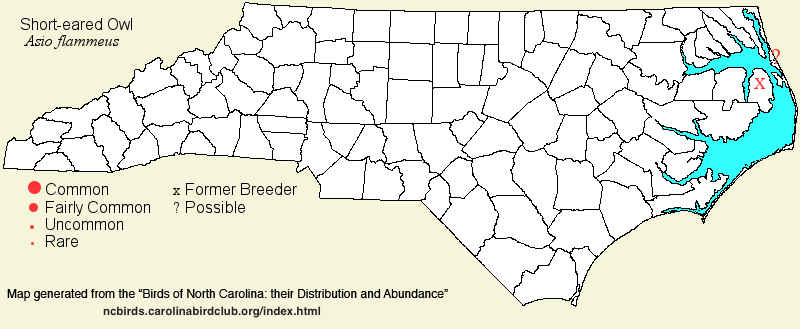 |  |
|
Short-eared Owl - Asio flammeus STRIGIDAE Members: | Search Common: Search Scientific: |
|
|
|||||||
| General Comments | The Short-eared Owl is the owl species most likely to be seen flying about in daylight hours, as a few can been seen in the winter months flying over marshes and wet fields in late afternoon. Though it has apparently bred on at least one occasion, and might possibly breed in very small numbers, in our coastal marshes and fields, most are seen in the cooler months, where it is the nocturnal counterpart of the Northern Harrier. Where many harriers are seen during the day, one should hang around near dusk to look for a Short-eared Owl or two to start flying, often while the last of the harriers are still cruising the marshes and fields, often with interactions between the two species. Numbers of the owls tend to vary considerably from winter to winter, likely owing to abundance or scarcity of rodents farther northward. The species is characteristically found at extensive brackish or fresh marshes (less so around salt marshes), as well as extensive open fields, typically where damp or wet. Inland, the species is difficult to find, and highest counts were from cleared beds of reservoirs, prior to filling. | ||||||
| Breeding Status | Accidental Breeder | ||||||
| NC BRC List | Definitive | ||||||
| State Status | W | ||||||
| U.S. Status | |||||||
| State Rank | SUB,S3N | ||||||
| Global Rank | G5 | ||||||
| Coastal Plain | Winter resident, and probable accidental/casual breeder. In winter, uncommon (to sporadically and locally fairly common) along the northern coast and in Tidewater; rare to uncommon along the central and southern coast; farther inland, generally rare in the northern Coastal Plain, but casual to absent farther south (e.g., no Sandhills records). Apparently bred at Alligator River NWR in 2001, as there were numerous summer sightings, with a peak count of six (family group?) in one small area. Mainly early Nov to late Mar. Peak counts: 30, near Belhaven (Beaufort), 21 Jan 2011; 26, Lake Phelps area, 28 Dec 1995; 20, Alligator River NWR, 1-10 Mar 2002; 18, Lake Phelps area, 19 Jan 1992. | ||||||
| Piedmont | Winter visitor. Very rare to rare, mainly from early Nov to late Mar; a preponderance of records were from the Falls Lake and Jordan Lake area, in the 1970's and early 1980's, when the cleared lakebeds contained extensive marshes, prior to filling. Most unusual were up to 3 from 29 Dec 2020 into March 2021 in the Brown Creek Valley area of Union. The 6 or 7 highest counts were from such habitats; since then (1983), all reports are of single birds. Peak counts: 21, Jordan Lake, 8 Feb 1981; 10 Jordan Lake, 14 Mar 1981; 5, Falls Lake, 6 Jan 1983. | ||||||
| Mountains | Winter visitor. Very rare in the southern mountains, with nine records, six from Hooper Lane in Henderson; one from Weaverville (Buncombe) in 1891; a shocking record from Hooper Bald in Graham (at apparently over 5,000 feet) on 1 Nov 2009; and just as odd was one at a high elevation at the Appalachian Highlands Science Learning Center, Haywood, on 31 Dec 2020. The Hooper Lane records fall between 3 Nov and 6 Apr, with a peak count of 3 during early 2000. Surprisingly there appears to be just one record for the northern mountains, where casual: one at Pond Mountain Game Land (Ashe), 15 Nov 2017. | ||||||
| Finding Tips |
A good technique for locating likely spots for Short-eareds is to find marshes or grasslands that have large (five or more) numbers of Northern Harriers. Alligator River NWR, near the maintenance shed on Milltail Creek Road or farther east down Long Curve Road, is the best place in the state to look for the owls, at dusk.
Sometimes these owls can be flushed during the day by walking through wet fields and marshes, or by flushing them from cedars and thick pine trees. On rare occasions, during dark cloudy weather, these owls will fly around during the day, usually an hour before sunset. ** | ||||||
| Attribution | LeGrand[2023-03-22], LeGrand[2021-05-17], LeGrand[2018-02-21] | ||||||
| NC Map Map depicts all counties with a report (transient or resident) for the species. | Click on county for list of all known species. |
| NC Breeding Season Map Map depicts assumed breeding season abundance for the species. |  |